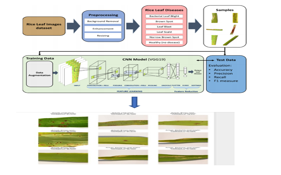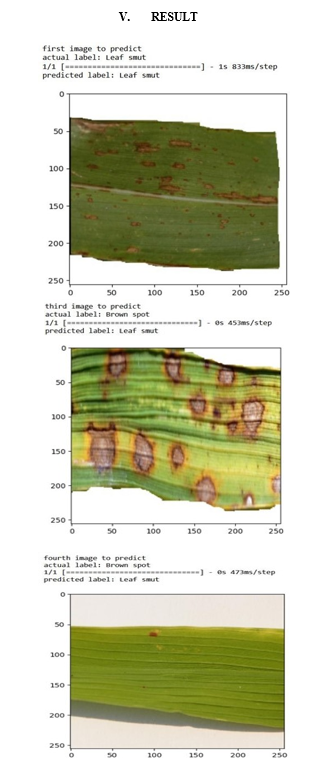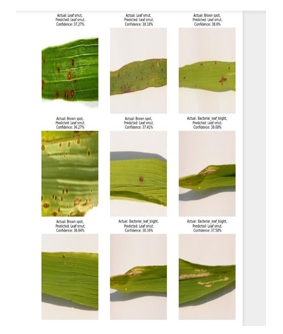Ijraset Journal For Research in Applied Science and Engineering Technology
- Home / Ijraset
- On This Page
- Abstract
- Introduction
- Conclusion
- References
- Copyright
Rice Leaf Disease Detection Using CNN
Authors: Sai Vivek Reddy Tummala , Vamshi Kummari, Akhilesh Kura, Akanksha Kallepu , Prof. Mohan Babu
DOI Link: https://doi.org/10.22214/ijraset.2023.54638
Certificate: View Certificate
Abstract
This paper presents a deep learning project that addresses Rice Leaf Disease Detection using convolutional neural Networks (CNN). We develop a novel deep learning model using a computer vision by image processing which detect the diseases like leaf smut, Brown spot, Bacterial leaf blight and with ReLU activation function by using adam optimization algorithm which evaluate its performance on rice leaf disease which shows the confidence. Our results demonstrate whether the given leaf has disease or not our approach outperforms existing methods in the literature and has potential for future applications like it can be made as mobile application or website. This paper contributes to the field of agriculture.
Introduction
I. INTRODUCTION
Rice is the most consumed foods in India as 50% population depends on it and also many countries depend on rice. Around 6,000 different types of rice cultivated in the India. As it takes major part in Indian economy. India is the world’s second-largest producer and exporter in the world. production is around 53.6 million tons-120 million tons.
Rice is the basic food crop which can be grown in hot and humid climate. It can be grown in places where annual rainfall is possible that is why it is known as kharif crop in India.It requires 25 degrees Celsius and above temperature and 100cm of rainfall. Mainly eastern and southern parts of India consume rice as food.
As mainly rice plant causes the diseases like Blast, Bacterial leaf Blight, Rice tungro disease, sheath Rot, Top false smut, Grain discolouration. Rice blast is mainly causing disease for rice plant which is responsible for approximately 30% of rice production losses which is equal of feeding 60 million people which increases rice price and reduce consumer welfare and food security.
II. LITERATURE REVIEW
Farmers typically employ visual inspection techniques to check for rice leaf diseases. Here are some common methods used by farmers for disease detection
- Visual Observation
Farmers regularly inspect their rice plants by visually examining the leaves for any signs of disease.
They look for characteristic symptoms such as lesions, discoloration, spots, wilting, deformities, or abnormal growth patterns on the leaves.
Farmers may compare the observed symptoms with reference images or consult agricultural extension services for assistance in disease identification.
2. Field Surveys
Farmers may conduct field surveys to systematically assess the overall health of their rice crops.
They inspect multiple plants across different locations within the field, looking for consistent symptoms or patterns.
Field surveys allow farmers to identify disease outbreaks and assess the severity and spread of the diseases in their rice fields.
3. Diagnostic Kits
Some farmers may utilize rapid diagnostic kits designed for on-site disease detection.
These kits often involve strip tests or immunological assays that detect specific pathogens or disease markers.
Farmers can collect samples from the affected plants, apply them to the diagnostic kit, and observe the resulting color changes or reactions to determine the presence of a particular disease.
4. Agricultural Extension Services
Farmers may seek assistance from agricultural extension services or local agricultural experts.
These professionals have expertise in plant diseases and can provide on-site visits or consultations to diagnose and advise on disease management.
Agricultural extension services may also organize training programs or workshops to educate farmers on disease identification and prevention.
A. Strengths
- Cost-effective: Visual inspection is a low-cost method that does not require any specialized equipment or resources. Farmers can rely on their own observations without additional financial burden.
- Familiarity with the Field: Farmers have extensive experience and knowledge about their crops. They are familiar with the typical growth patterns, leaf appearance, and signs of diseases in their rice plants.
- Timely Detection: Farmers regularly monitor their crops, allowing for early detection of diseases. Prompt identification can lead to timely intervention and effective disease management strategies, minimizing crop damage.
B. Weaknesses
- Limited Expertise: Farmers may lack comprehensive knowledge about specific diseases, especially emerging or rare ones. Some diseases may have similar symptoms, making accurate identification challenging without expert assistance or laboratory testing.
- Lack of Precision: Visual inspection may not always detect diseases in the early stages or identify latent infections that do not exhibit visible symptoms yet. This can lead to delayed or missed diagnoses, allowing diseases to progress and cause more significant damage.
- Scalability: Visual inspection becomes challenging when dealing with large-scale or extensive rice fields. It may not be feasible for farmers to inspect every plant thoroughly, potentially missing disease symptoms in certain areas of the field.
III. PROBLEM STATEMENT
Rice leaf diseases pose a significant threat to global food security by causing yield losses and reducing crop quality. Early and accurate detection of these diseases is crucial for timely intervention and effective disease management. While traditional methods of disease detection rely on visual inspection by farmers, they often lack consistency, precision, and scalability. Hence, there is a need to develop an automated and reliable system for rice leaf disease detection.
The problem addressed in this study is to design and develop a robust and accurate rice leaf disease detection system using Convolutional Neural Networks (CNNs). The CNN-based approach aims to leverage the power of deep learning and computer vision to analyze images of rice leaves and accurately identify disease symptoms. By automating the detection process, the system aims to provide farmers and agricultural professionals with a tool that can rapidly and consistently identify diseases, enabling timely interventions and precise disease management strategies.
IV. METHODS
The architecture of rice plant disease detection using CNN involves the design and arrangement of layers within the Convolutional Neural Network (CNN) model. Here is an overview of the typical architecture used in rice plant disease detection:

A. Input Layer
The input layer of the CNN receives the rice leaf images for disease detection.
The dimensions of the input layer are determined by the size of the input images.
B. Convolutional Layers
Convolutional layers are the core building blocks of the CNN architecture.
Each convolutional layer consists of multiple filters or kernels that slide over the input images to extract features.
The filters capture patterns, edges, and textures at various spatial scales.
The output of each convolutional layer is a set of feature maps, where each map represents the response of a specific filter.
C. Activation Function
Activation functions, such as ReLU (Rectified Linear Unit), are applied after each convolutional layer.
ReLU introduces non-linearity to the network, allowing it to learn complex representations and make the model more expressive.
D. Pooling Layers
Pooling layers reduce the spatial dimensions of the feature maps, capturing the most salient features.
Max pooling is commonly used, where the maximum value within a pooling window is selected as the representative feature.
Pooling helps in downsampling the feature maps, making the network more robust to translations and reducing the computational requirements.
E. Fully Connected Layers
Fully connected layers follow the convolutional and pooling layers and perform classification based on the extracted features.
These layers are typically located at the end of the network and consist of neurons that are connected to all the neurons in the previous layer.
The output of the fully connected layers is passed through a softmax activation function to obtain probability distributions over disease classes.
F. Output Layer
The output layer of the CNN produces the final disease classification based on the probabilities generated by the fully connected layers.
The number of neurons in the output layer corresponds to the number of disease classes to be detected.
G. Pre-processing Steps
- Image Resizing
Rice leaf images are often resized to a fixed input size to ensure consistency during training and inference.
Resizing reduces computational requirements and allows the model to process images of the same dimensions.
2. Normalization
Normalization is performed to standardize pixel values across the images.
Commonly, normalization involves scaling the pixel values to a range of [0, 1] or [-1, 1].
This step helps in stabilizing the training process and enhances model convergence.
3. Image Enhancement
Image enhancement techniques, such as contrast adjustment or histogram equalization, may be applied to improve the visibility of disease symptoms.
Enhancing the image quality can help the CNN to extract more informative features during training.


Conclusion
In conclusion, the use of Convolutional Neural Networks (CNNs) for detecting rice leaf disease has yielded promising results. CNNs are deep learning models that were developed specifically for image processing tasks and have been successfully applied in a variety of fields, including computer vision and medical imaging. CNNs have been used to automatically analyze images of rice leaves and classify them into healthy or diseased categories in the detection of rice leaf disease. The CNN model can learn to recognize patterns and features indicative of various diseases by training it on a large dataset of labelled images. The advantages of using CNNs for rice leaf disease detection are: 1) High Accuracy: CNNs have consistently outperformed traditional machine learning algorithms in image classification tasks. They can capture intricate patterns and subtle differences in leaf texture, color, and shape that humans cannot see. 2) Automation: CNN-based systems can process large volumes of images automatically, allowing for efficient and rapid disease detection. This is especially useful for farmers and agricultural experts who require quick and accurate crop health assessments. 3) Scalability: Once trained, a CNN model can be deployed on a variety of platforms, including mobile devices and embedded systems, allowing for real-time disease detection in the field. Because of its scalability, it is accessible to a broader range of users and aids in disease management on a larger scale. 4) Generalization: CNN models have demonstrated the ability to generalize well to previously unseen images, implying that they can accurately detect diseases even when presented with new and previously unseen leaf samples. This adaptability is critical in dealing with the wide variety of disease variants encountered in real-world scenarios. To ensure reliable results, CNN-based disease detection systems require a large and diverse dataset for training, as well as a rigorous validation process. Furthermore, the model may need to be updated and retrained on a regular basis to accommodate new disease strains or variations. Overall, using CNNs to detect rice leaf disease has the potential to improve crop management, increase yields, and reduce the economic impact of plant diseases. Continued research and development in this field may result in even more accurate and robust disease detection systems, which will benefit farmers while also contributing to global food security.
References
[1] Lu, J., Hu, J., Zhao, G., Mei, F., and Zhang, C. (2017a). An in-field automatic wheat disease diagnosis system. Comput. Electron. Agric. 142,369–379. doi:10.1016/j.compag.2017.09.012 [2] Lu, Y., Yi, S., Zeng, N., Liu, Y., and Zhang, Y. (2017b). Identification of rice diseases using deep convolutional neural networks. Neurocomputing 267, 378–384. doi: 10.1016/j.neucom.2017.06.023 [3] Ngugi, L. C., Abelwahab, M., and Abo-Zahhad, M. (2020). Recent advances in image processing techniques for automated leaf pest and disease recognition – a review. Inf.Process. Agric. 4:4. doi: 10.1016/j.inpa.2020.04.004 [4] Picon, A., Seitz, M., Alvarez-Gila, A., Mohnke, P., Ortiz-Barredo, A., and Echazarra, J. (2019). Crop conditional Convolutional Neural Networks for massive multi-crop plant disease classification over cell phone acquired images taken on real field conditions.Comput. Electron. Agric. 167:105093. doi: 10.1016/j.compag.2019.105093 [5] Polder, G., Van de Westeringh, N., Kool, J., Khan, H. A., Kootstra, G., and Nieuwenhuizen, A. (2019). Automatic detection of tulip breaking virus (TBV) using a deep convolutional neural network. [6] Sambasivam, G., and Opiyo, G. D. (2020). A predictive machine learning application in agriculture: Cassava disease detection and classification with imbalanced dataset using convolutional neural networks. Egypt. Inform. J. 2:7. doi: 10.1016/j.eij.2020.02.007 [7] Selvaraju, R. R., Cogswell, M., Das, A., Vedantam, R., Parikh, D., and Batra, D. (2016). Grad- CAM: visual explanations from deep networks via gradient-based localization. arXiv 2017:74. doi: 10.1109/ICCV.2017.74
Copyright
Copyright © 2023 Sai Vivek Reddy Tummala , Vamshi Kummari, Akhilesh Kura, Akanksha Kallepu , Prof. Mohan Babu. This is an open access article distributed under the Creative Commons Attribution License, which permits unrestricted use, distribution, and reproduction in any medium, provided the original work is properly cited.

Download Paper
Paper Id : IJRASET54638
Publish Date : 2023-07-06
ISSN : 2321-9653
Publisher Name : IJRASET
DOI Link : Click Here
 Submit Paper Online
Submit Paper Online

